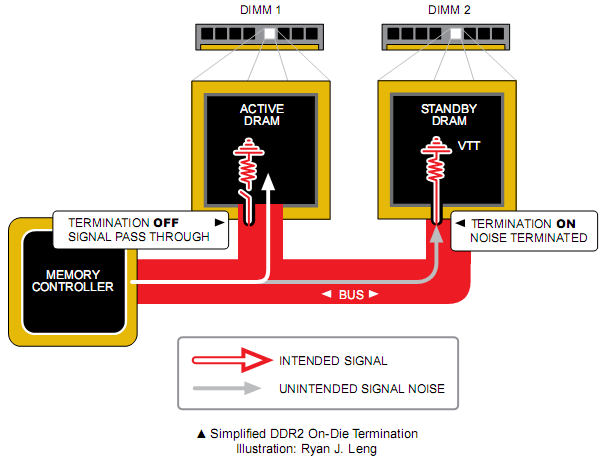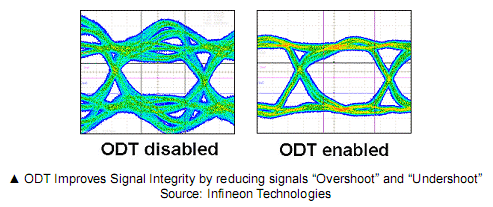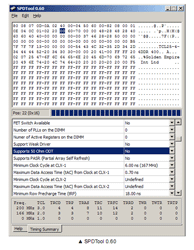
Signal Noise Management with On-Die Termination (ODT)
As more features are added into the motherboard and performance continues to increase, it becomes harder and harder to maintain signal integrity. Unwanted signal reflection is a serious problem when moving beyond DDR1 speeds with the existing motherboard resistive termination scheme.
An increase in memory bus frequency reduces the margins for signals to recover from anomalies explained in previous sections. A more compressed signal with lower voltage is fundamentally weaker in nature and while not all jitters can be removed from the Data Strobes (DQS), any mechanism that reduces negative effects on the edges of the wave is inherently good.

DDR2 On-Die Termination (ODT) improves signal integrity by building dynamic resistive technology within the memory chip itself. This reduces the material and testing cost for motherboard manufacturers on top of other benefits. Unintended signals can bounce off from either active or passive components, but only active components like DRAMs are adversely affected. ODT negates the negative effects of signal echoes along the bus during read-write operations at the chip level.
 Ironically, if the termination is too effective, it is possible the data signal can be absorbed when the memory timing is inaccurate – overclocking can sometimes result in this data truncation memory error.
Ironically, if the termination is too effective, it is possible the data signal can be absorbed when the memory timing is inaccurate – overclocking can sometimes result in this data truncation memory error.The BIOS in some motherboards allows the user to manually adjust the resistive nature of ODT between 50, 75, 150 ohms. According to JEDEC specification, 50 ohms is a mandated for DDR2-667 and beyond on some platforms.
To know if your memory modules support 50 ohms with certainty, a program called SPDTool can be used to view the pre-defined memory performance values and characteristics. Motherboard designers are required to properly simulate and tests READ and WRITE signalling quality based on various ODT configurations in order to find the requirement for the best Data Eye aperture.
The simulation sessions can be exhaustive and time consuming as they involve collecting Data Eye aperture figures based on combinations of motherboard impedances and ODT settings against multitude of memory modules in different slot configurations. This is partly why cheap motherboards only have two slots.

MSI MPG Velox 100R Chassis Review
October 14 2021 | 15:04









Want to comment? Please log in.